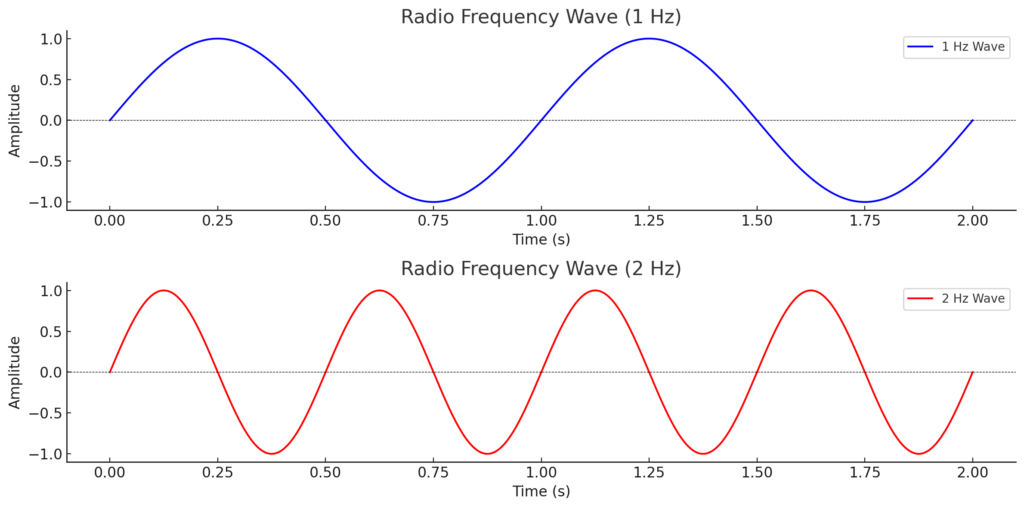Hi there, this is Maher Haddad here. In this lesson will have an overal idea about the Radio Frequency and Wireless Communication. First thing we have to speak about is the radio frequency. So, what is radio frequency? We’ll also go through what is frequency, what is a wave, and what is wavelength. All of these concepts are going to be covered in this lecture. Let’s start directly with the explanation.
The Electromagnetic Spectrum
It’s very important to know that there is something we call the electromagnetic spectrum. The electromagnetic spectrum is where all frequencies exist. For example, X-rays work on a certain range of frequency. If you speak about radio waves, the long radio waves work on different frequencies; for example, AM and FM radios operate within a specific range. Microwaves work on another frequency, and visible light—the light that we can see—also works within a unique frequency range.
Radio frequency (RF) is a portion of the electromagnetic spectrum, and it fits in here. This is where we use the 802.11 standard, which is for wireless communication. So, the Wi-Fi network uses the radio frequency in the microwave range. This is the frequency that we use.

Radio Frequency as a Carrier for Data
Radio frequency acts as the carrier used to modulate data, meaning it manipulates radio frequency waves so they represent digital data bits. We’ll speak later about modulation in more detail, but here’s a quick example. Imagine you’re sending data from a wireless link on a tower outdoors. After 10 kilometers, you have another tower, and you’re connecting them with this wireless link.
The data you send from tower A can reach 10 kilometers to the other tower through the medium of radio frequency. Modulation is the process that allows the waves traveling from point A to point B to represent digital bits. If someone is making a phone call over VoIP, modulation enables their voice to be transmitted through radio frequency and received on the other end, understood as digital data.
Modulation means manipulating the radio frequency wave so it represents digital data bits. Computers, VoIP phones, or other devices understand this digital data. So, remember that we have the electromagnetic spectrum where all frequencies are organized, and we’re focusing on the part for radio frequency within the microwave range.
Waves and Their Transmission
Since we’re discussing radio frequency, we know that the transmission medium we’re using is a wave. Think of a wave as similar to the ones you see in the ocean; it’s an oscillation that travels through a medium. For wireless communication, our medium is the air.
Waves can be generated intentionally or incidentally:
- Intentional waves are produced by equipment designed for radio frequency communication, like wireless access points with antennas. Their purpose is to transmit data from one side to another through the air.
- Incidental waves are created unintentionally by devices like electric motors and other machinery. These waves are not meant for communication and can interfere with nearby wireless signals. For example, if an electric motor is working near an access point, you might experience signal interruptions. This interference happens because the motor emits incidental waves that disrupt the radio frequency of the access point.

Understanding Waves and Wavelength
Radio frequency waves serve as the medium for transmission. Here’s a representation of a wave: it goes up and down over time, creating a cycle. This is what we call a wavelength. This chapter will cover more on wavelength, but for now, let’s focus on the concept of a wave.
A wave includes both positive and negative parts, and using this wave, we can transmit data to another location. Remember, if you increase the wave’s power, its amplitude can become larger, which affects transmission.

We also have frequency and wavelength to consider. When frequency is high, the wavelength becomes shorter, meaning the signal won’t reach as far. In contrast, a lower frequency means a longer wavelength, which can cover greater distances.

Here below you can see the how the Wavelength change based on the Low and High frequencies:

Wrapping Up
I’ll pause this explanation for now. In the next lecture, we’ll continue exploring frequency and wavelength in more depth. This is all I wanted to show you in this lecture. I hope it was informative, and I look forward to seeing you in the next one.

0 Comments